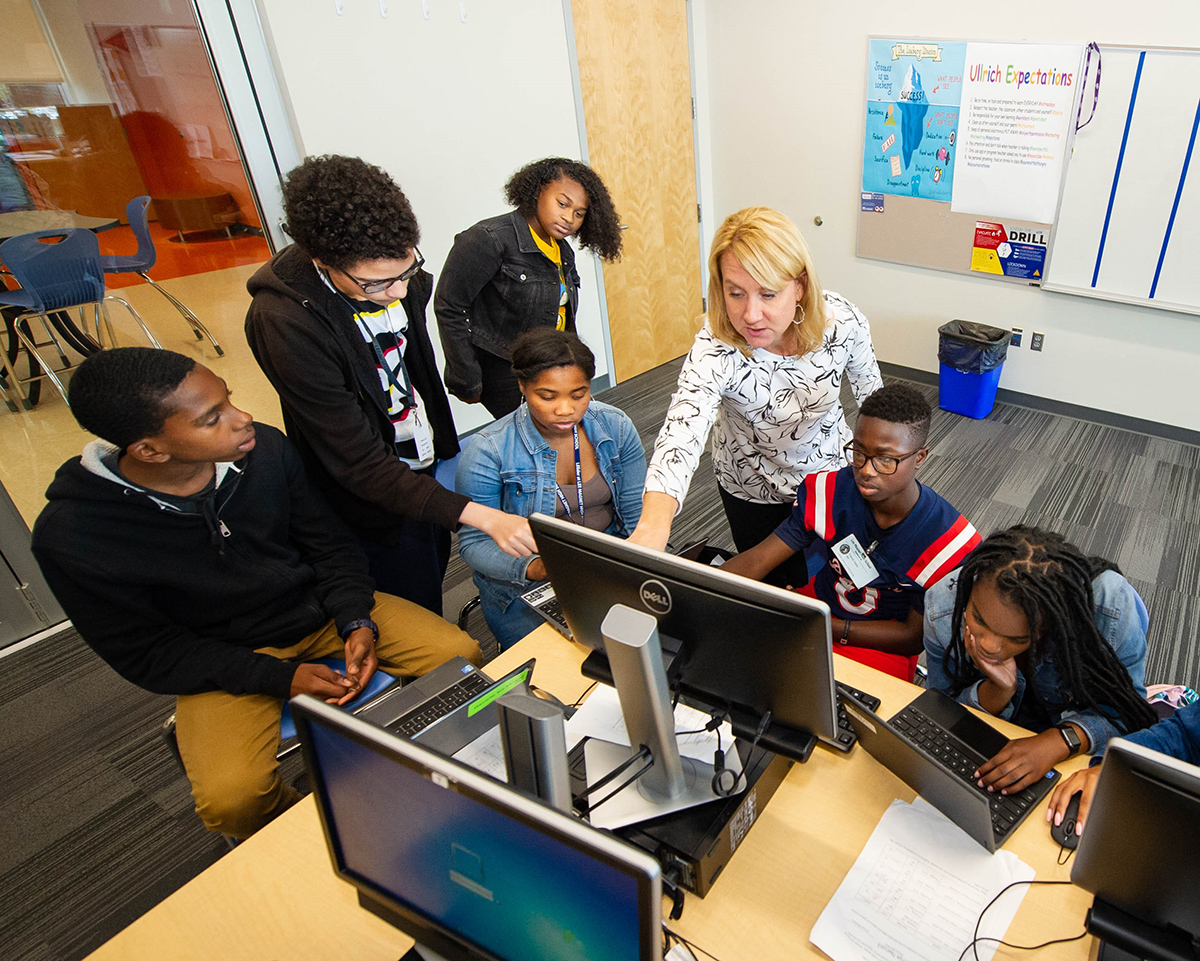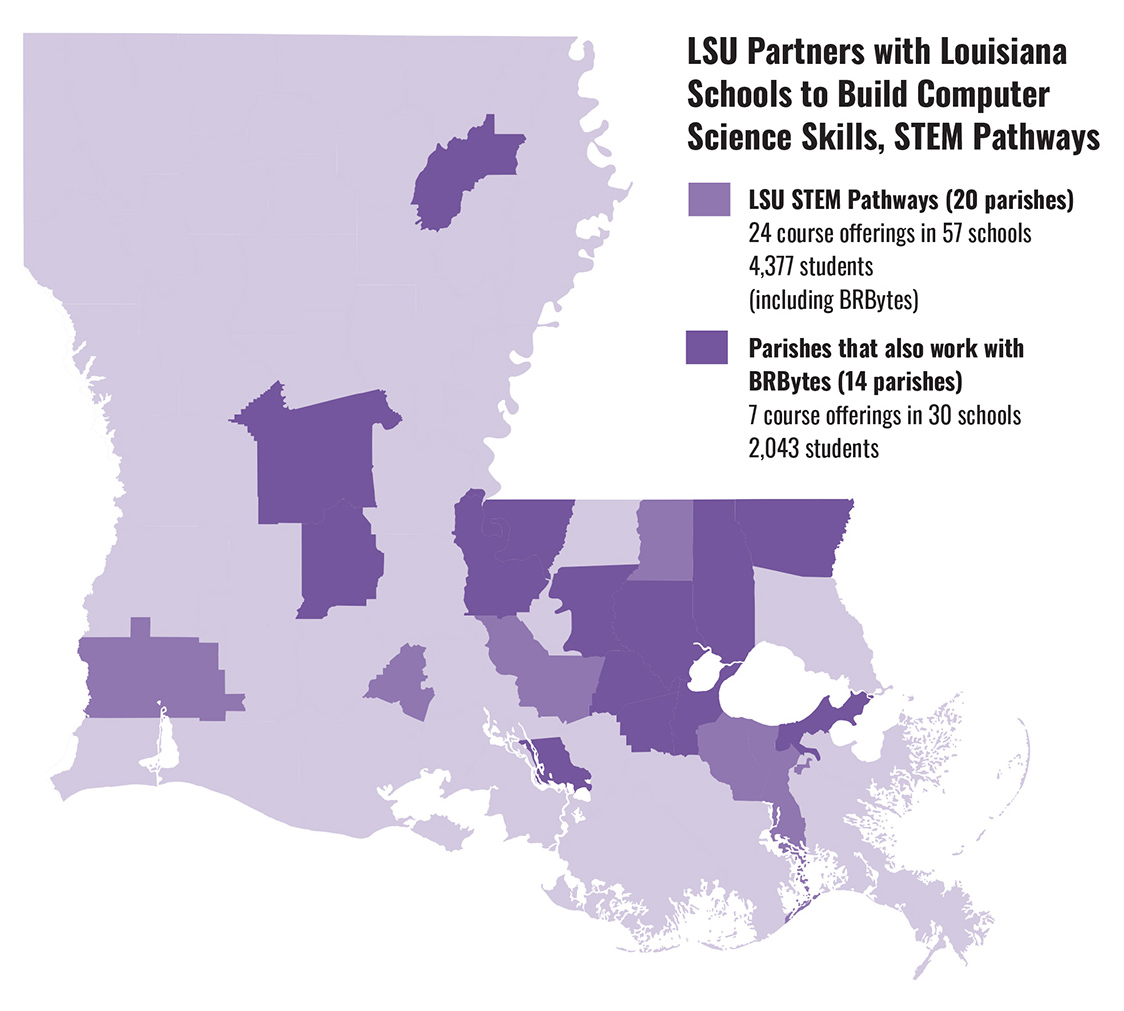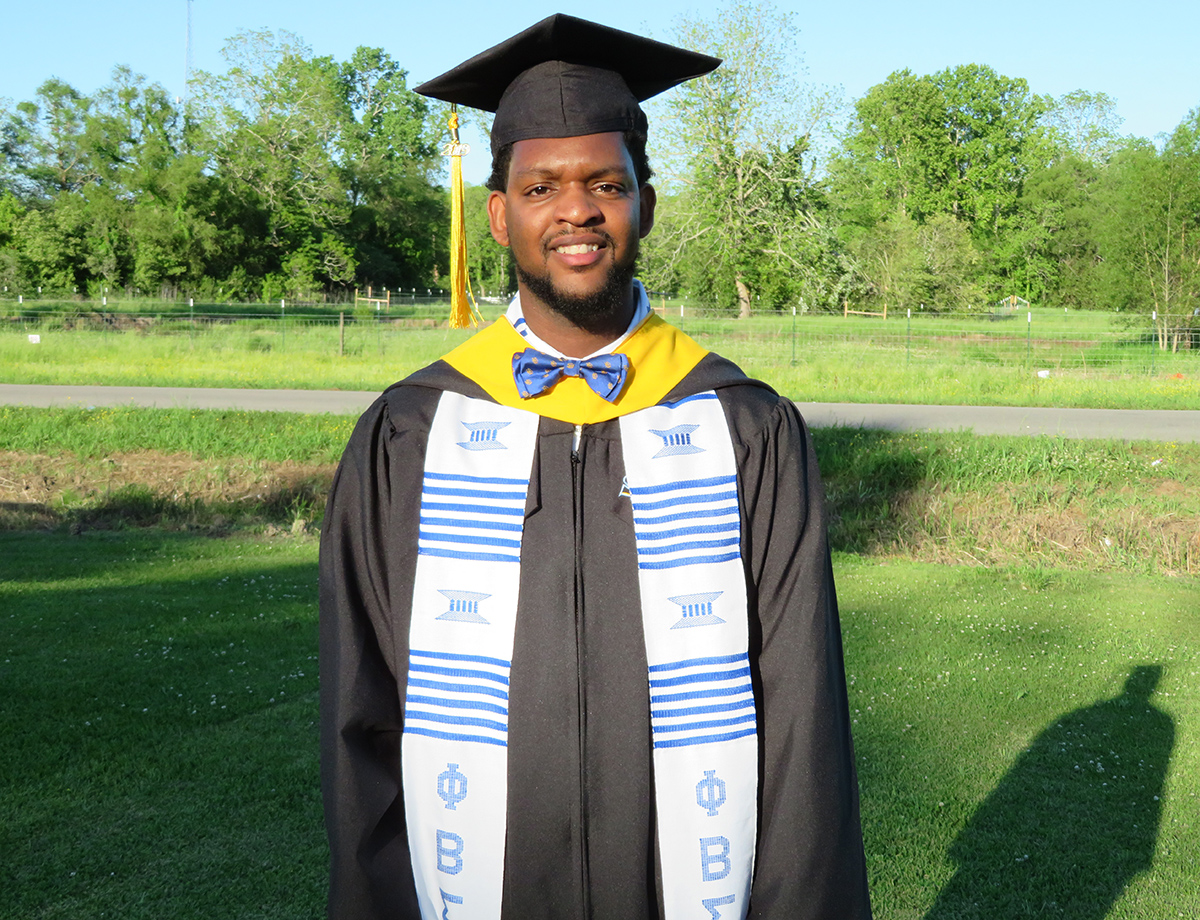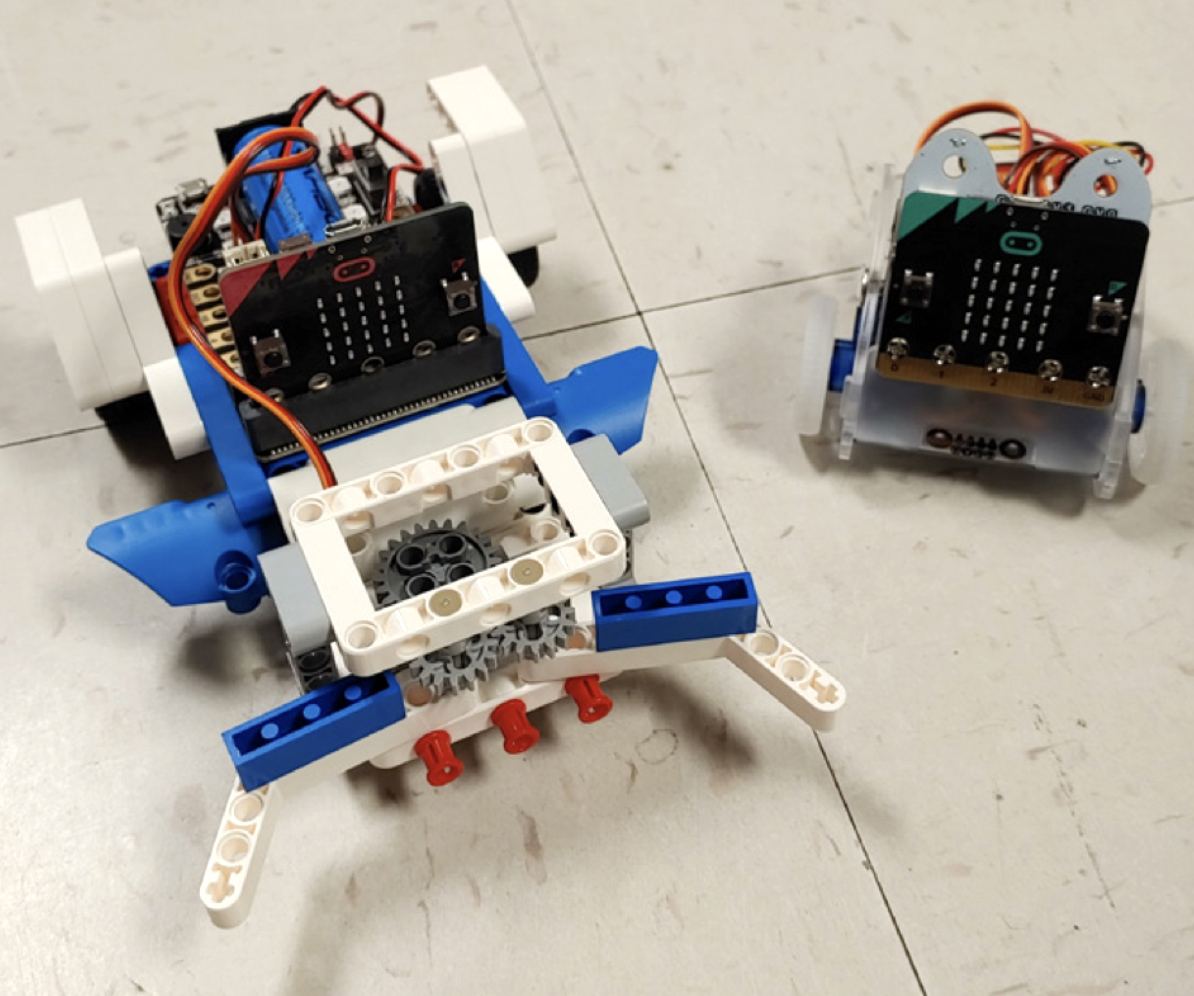Big Bytes: LSU Program to Help Teach Computer Science and Computational Thinking Skills in Louisiana High Schools and Lower Grades Quickly Expands Across State
April 05, 2021

Liberty High School students and teacher Katy Ullrich were part of the first cohort to teach Introduction to Computational Thinking as part of the LSU BRBytes program.
– Photo credit: Elsa Hahne
BRBytes, leveraged by the LSU STEM Pathways program, has gone from a handful of schools to 30 schools in 14 parishes in two years, despite the COVID-19 pandemic.
The LSU BRBytes program, which began in partnership with East Baton Rouge Parish School System (EBRPSS) at five EBRPSS high schools in 2019 to help build computer science and computational thinking skills—and importantly, careers—for students before they get to college. It initially received $1 million in support from the National Science Foundation. It then quickly expanded to include more schools in East Baton Rouge and four rural Louisiana parishes (Evangeline, Pointe Coupee, Washington, and West Feliciana) with a $4 million award from the U.S. Department of Education.
Today, just two years later and with no additional funding, the program has spring-boarded into a total of 14 Louisiana parishes. BRBytes is part of the national initiative CSforAll to make computer science training available to all students, regardless of background.
Members of the BRBytes team began developing computing curricula and training Louisiana high school teachers in 2015 under the umbrella of the new LSU STEM Pathways program. Those teachers, in turn, brought those courses into Louisiana schools in 2016. But it quickly became clear that while suburban districts jumped on the opportunity to offer computing courses, urban and rural schools did not. To remediate this situation, EBRPSS and LSU formed the BRBytes partnership to try to bring about the much bigger, systemic change that would be necessary to actually make computing courses available to all students, regardless of their race, ethnicity, gender, or socioeconomic status.
Computer and mathematical occupations are projected to have the largest 10-year growth among all occupations in Louisiana. Meanwhile, only a few public schools (23%) were teaching computer science courses when BRBytes started. The interdisciplinary LSU team behind BRBytes quickly developed their first core offering, Introduction to Computational Thinking, and then added five more: Cybersecurity, Data Manipulation and Analysis, Programming for STEM, Introduction to STEM Pathways and Careers, and Survey of Computer Science. (STEM, of course, stands for science, technology, engineering, and mathematics.) The latter two are now taught in Louisiana middle schools as a bridge to more advanced topics. This fall, the team is introducing yet another course: Interactive Computing, where students will program objects that interact with the world around them, such as robots.

In just two years, BRBytes has expanded from a handful of schools to 30 schools in 14 parishes, leveraged by the LSU STEM Pathways program, managed through the LSU Gordon A. Cain Center for STEM Literacy.
– Illustration credit: Elsa Hahne
Aside from developing courses, the LSU team is also developing Louisiana teachers. BRBytes has so far trained 33 high school and 16 middle school teachers of 2,043 students in 30 schools. One of them is Marqual Battley-Brown, a computer science graduate of Southern University who began teaching Introduction to Computational Thinking last fall to 9th and 10th graders at STEM Magnet Academy of Pointe Coupee, not far from where he grew up in Ventress, Louisiana (population 1,100).
“Computer science is everywhere and no matter what you do in life, you will deal with computers, and that’s what I’m trying to help the students see,” Battley-Brown said. “Even if you work in a grocery store; the inventory is computer science, the scan-and-go system is computer science, and the camera system is computer science. Computer science is everywhere and likely to help you in any career you choose.”
Battley-Brown remembers, in his own education, how some early training in computer science could have benefited him greatly.
“In college, I experienced other kids catching on faster because they’d been exposed to some things in high school,” he explained. “That’s why I was highly enthused to be able to offer this to our students. And even if they don’t always take it seriously, I know it can be life-changing—learning how to code is learning a foreign language, but a language that’s used and applicable everywhere, no matter where you go. That’s why we’re now talking about expanding what our school does with BRBytes to add more courses for more students.”
BRBytes courses are currently taught in 14 parishes across the state: Ascension, East Baton Rouge, Evangeline, Livingston, Orleans, Pointe Coupee, Rapides, Richland, St. James, St. John, St. Martin, Tangipahoa, Washington, and West Feliciana. Among the total of 2,043 students, about 62% are underrepresented minorities (mostly Black) and just about as many (61%) come from economically disadvantaged backgrounds. However, about three-quarters of the students (1,505) are at schools that now receive financial support through the BRBytes project, and 73% of those students are underrepresented while 77% are economically disadvantaged.
“Computer science is everywhere and no matter what you do in life, you will deal with computers, and that’s what I’m trying to help the students see ... learning how to code is learning a foreign language, but a language that’s used and applicable everywhere, no matter where you go.”
Marqual Battley-Brown, teacher at STEM Magnet Academy of Pointe Coupee
Leveraged by the LSU STEM Pathways program, BRBytes is positioned to continue to grow—LSU STEM Pathways is now active in 20 parishes and offers more than 24 different STEM courses, including the BRBytes ones, to 4,377 students in 57 different schools. BRBytes will also improve not just its reach but its performance—students will be taught more effectively over time. This is because there’s a robust research component of BRBytes, where the LSU faculty team is evaluating how and how much students are learning, essentially using science to teach science.

Marqual Battley-Brown, a computer science graduate of Southern University, is helping to bring BRBytes courses to the STEM Magnet Academy of Pointe Coupee.
– Photo courtesy of Marqual Battley-Brown
“With the funds from the National Science Foundation CSforAll award, we are researching how culturally relevant pedagogy implemented by trained BRBytes teachers influences student engagement,” Moreno said. “The Department of Education’s EIR funds are helping to improve the Introduction to Computational Thinking curriculum and to better align it with math standards.”
In their conversations with schools, the BRBytes team is quick to point out that although their courses are elective and not part of the core requirements (unlike English, math, social studies, and science), preliminary data—based on observations by middle and high school teachers—show that students who take BRBytes courses tend to also improve their performance and test scores in math and science, since the subjects are interlinked and support each other.
The same is likely true for the broader LSU STEM Pathways program, which, in “pilot parishes” like Livingston and West Feliciana (by demand from local schools), is starting to expand into lower grades; middle school, even elementary school and kindergarten. This is happening in collaboration with Louisiana principals and school directors, such as Michael Simmons, head of the Denham Springs High School STEM and Robotics Center in Livingston Parish, who chose to act on the knowledge that the key to success in upper grades is kindling interest and foundational skills in younger students. Knowledge begets knowledge.
“Expanding our curriculum down to the elementary and middle schools will grant us the opportunity to build a cohort of STEM learners rising together from kindergarten to graduation,” Simmons said. “It will also ensure that the curriculum is vertically aligned, and every student is learning the necessary skills they will need in the next grade level and beyond.”
“ Preliminary data—based on observations by middle and high school teachers—show that students who take BRBytes courses tend to also improve their performance and test scores in math and science. ”
“We see the skill deficit when our students come to us,” Simmons continued. “Right now, when a student reaches 9th grade and enrolls in STEM electives, they have little-to-no knowledge of robotics, coding, and digital media. Building those skills in the lower grades will make our students STEM proficient.”
Three Denham Springs junior high schools will be adopting LSU’s 7th and 8th grade curriculum this fall, where students can earn high school credit. The curriculum for kindergarten through 6th grade has not been created yet, however. This will happen in partnership with LSU this summer and beyond.

This fall, BRBytes will introduce yet another course, Interactive Computing, where students program objects that interact with the world around them, such as robots.
– Photo credit: Jessica Moon
“We’re not creating a new, stand-alone STEM subject,” Simmons said. “Instead, we’ll be integrating it into the lessons the students are already learning every day in Math, ELA, Science, Social Studies, etc. This is a tremendous task we are asking of our teachers and administration, but with support from LSU, we have no doubt they will be quality lessons with valuable STEM components.”
In developing STEM classes for high school, any program must also have some level of flexibility in terms of the total “package” offered, says Frank Neubrander, professor of mathematics and executive director of the LSU Gordon A. Cain Center for STEM Literacy, which manages the LSU STEM Pathways program.
“We have to keep in mind that students are growing and can be different people in 11th grade than in 9th grade; their interests and priorities change,” Neubrander said. “This is why it’s so important to offer core courses, such as Introduction to Computational Thinking, in 9th and 10th grade, so students don’t become locked into a specific pathway but can go from there further into engineering or digital design or cybersecurity or biomedical sciences, with more doors open to them.”
“This is a tremendous task we are asking of our teachers and administration, but with support from LSU, we have no doubt they will be quality lessons with valuable STEM components.”
Michael Simmons, head of the Denham Springs High School STEM and Robotics Center in Livingston Parish who is trying to bring computer science training into lower grades, as early as kindergarten
He echoes Battley-Brown’s remark about treating computer science and coding as a foreign language:
“We see this in our teacher trainings, when teachers come to us at LSU for three or six weeks in the summer—we had 136 teachers coming to us to learn how to teach STEM courses last summer, among them English, French, and history teachers—and our language and humanities teachers do great; they often surprise themselves.”
LSU and the Gordon A. Cain Center also offer a dual enrollment program where Louisiana high school students can earn college credits—that program is growing, too, from an enrollment of 5,300 students to 6,000 students just this year, despite the COVID-19 pandemic.